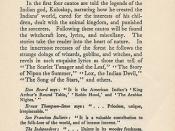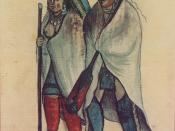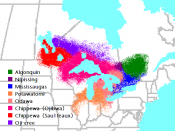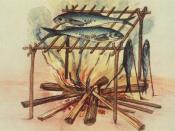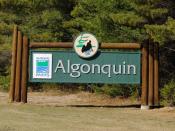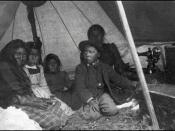A rich and plentiful countryside, peaceful nation, and temperate climate provided everything the Algonkin people needed. The forest provided nut harvests, and animals they hunted such as deer, turkey, bear, raccoons, and others. Also from the land, they made their weapons, houses, medical remedies, and clothing, which consisted of leathered or sueded cloth with emblems or symbols. From the marshes the people collected cord grass, muskrats, rice, and arrowroot for bread. On shallow mud flats, they caught crabs, clams, and harvested oysters. Finally the rich soil brought them the ability to grow corn, beans, squash, tobacco, and sunflowers. Relying on such a diverse culture, these people shared many substantial patterns such as fishing, collecting, gathering, hunting, and agriculture. Within two hundred years, French and Europeans would arrive and change that peaceful nation forever.
The Algonquin or Algonkin, lived in bands of one hundred to three hundred members. Each band was dividing into hunting groups of up to twenty-five close relatives.
From their many natural resources, they collected saplings and birch bark to bend and stretch to make their lodge house. In each house there lived a husband, a wife, their young children and unmarried grown-up daughters, and their married sons with their own wives and children. Surviving and deriving off the land was essential. They relied on their, knowledge of the land, spiritual belief, and closeness of families to survive.
Their climate wasn't really harsh, but in the winter, it was quite cold. The Algonkins lived up north in an area we know today as Ontario and Quebec. In winter, they hunted deer, mouse, and other animals. The rest of the year they gathered wild fruits, nuts, and roots. The Algonquins were also experts at building and handling canoes. They traveled by canoe in the summer and in the winter they traveled by toboggans and snowshoes.
Historically, there is proof that Algonquins were matrilineal- tracing their descent and inheritance through the women of the tribe. Women owned the houses, fields, children, and women also enjoyed a considerable amount of freedom. They were also tightly woven with language. Although the Algonkins are mostly recognizable for their language (Algonquin), they are not the only tribe who spoke Algonquin or a form of the language. The Cheyenne, Arapaho, Gros Ventres, Blackfoot, Cree, and the Ojibwe, all speak forms of Algonquin- the language. The reason for this wide-spread language use is because of the colonization into other tribes, and trade. Indians traded to make friends and to share their natural resources, without depleting them.
